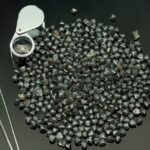Bain & Co.’s sixth annual report on the global diamond jewellery market says that the global diamond industry performed “moderately well” in 2015. The industry’s performance was led by diamond jewellery retail sales, which, the report says, grew three per cent at constant exchange rates.
“However, currency depreciation last year, as well as slower demand in China, contributed to a decline in global revenue of about 2 percent in U.S. dollar terms,” said Bain & Co. in a press release on the report. “Similarly, in the midstream, U.S. dollar revenues dipped by 2 per cent and rough diamond sales fell nearly a quarter (24 per cent). That decline was the result of reduced purchasing volumes in the cutting and polishing sector and the release of about US$ 5 billion of their inventories into the downstream markets.”
The report says that the diamond jewellery market was relatively stable last year and the US remained the “global sales growth engine” for the sector. Greater China reflected a mixed bag as far as diamond jewellery sales went – while Mainland China was generally positive, lower tourist traffic in Hong Kong and Macau impacted sales in those regions.
“This shift in tourist spend benefitted Europe and Japan, as reflected in positive consumption growth in local currencies,” concluded the report. “In India, strong macro-demographics, particularly the growing middle-class, supported positive gains. Yet, even these positive trends were no match for the strong U.S. dollar, which drove global markets into negative growth rates.”
“In 2015, the diamond jewellery and midstream segments showed relative stability, but the same cannot be said for rough-diamond producers, which experienced a double-digit revenue decline,” said Olya Linde, a Bain partner and lead author of the report. “Although demand for rough diamonds has rebounded so far in 2016, the holiday season will determine the retail and midstream segments’ full-year performance.”
The report cautioned that though there seems to be some recovery, “headwinds persist”. Some of these challenges include, the report enumerated, secure access to financing within the midstream sector; slowing consumption in China; and the ongoing threat of synthetics and counterfeit diamonds.
The silver lining in this scenario, according to the report — “the sheer number and growing spending power of Millennials, as well as strong overall macro fundamentals presents a glimmer of hope over the mid- to long-term”.
The report was jointly prepared by the Antwerp World Diamond Centre (AWDC) and Bain & Company. The two organisations also conducted a survey of more than 1,500 Millennials in China, India and the U.S.
“The population of Millennials in these countries totalled roughly 900 million in 2015, and their combined gross income amounted to approximately $8 trillion,” the survey found. “Taken together, they are the fourth largest economy, behind the U.S., European Union and China, and are likely to double to some US$ 16 trillion, or 38 percent of total gross income, by 2030. Like earlier generations, they rank jewellery high among their gifting preferences—it is first in China and India and third in the U.S., behind money and electronics.”
The report pointed out that there were differences in shopping behaviour which “suggest that revised marketing and customer acquisition strategies are needed to reach this group of customers effectively”.
Elaborating the point, the report added: “In the U.S., Millennials actively use the internet for jewellery purchases; in India they tend to prefer department stores. Chinese Millennials, like other age groups in China, prefer specialised retailers for jewellery shopping and tend to make their purchase decisions in stores. To fully capture Millennials’ demand over the longer term, industry players need to invest in marketing and brand-building efforts and redefine the customer’s retail experience.”
“As this new generation of consumers heads toward its prime spending years, the diamond industry needs to find ways to effectively engage with them now,” said Linde. “Smart producers and retailers are actively looking for ways to appeal to them. Those that don’t will encounter yet another hurdle to overcome in an already-turbulent market.”
According to the report the diamond industry’s outlook in the medium-term “remains challenging, as new supply is expected to come on line and uncertainties cloud the social, political and economic environments in key markets”.
However, the report opined that in the long term, “positive macroeconomic outlook is expected to work in the industry’s favor—as long as diamond producers behave responsibly and industry players sustain their marketing efforts to support diamond jewelry demand, especially among Millennials”.
“AWDC is pleased to present the results of our collaboration with Bain in this, our sixth annual report on the global diamond jewelry market. AWDC initiates these reports, which are distributed freely, out of the firm conviction that an informed diamond industry will make more intelligent decisions to the benefit of all,” said Ari Epstein, CEO of the Antwerp World Diamond Centre. “It is important that we realise, as does the DPA, for instance, through the ‘Real is Rare’ campaign, that we will only prosper when we achieve principled solidarity throughout the diamond pipeline, upon which we engage in fair competition. I therefore invite everyone to enjoy the fruits of our efforts.”
News Source : gjepc.org
Disclaimer: This information has been collected through secondary research and TJM Media Pvt Ltd. is not responsible for any errors in the same.




























